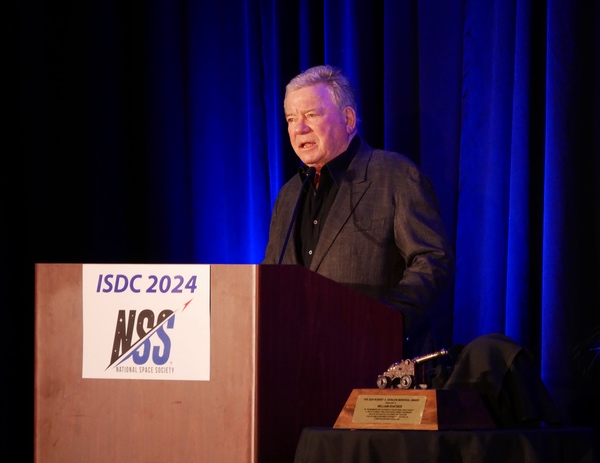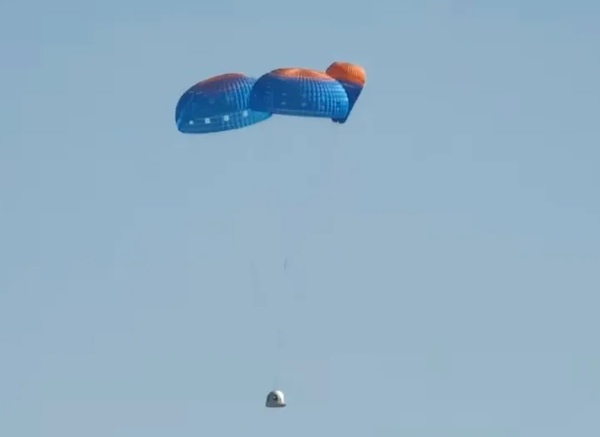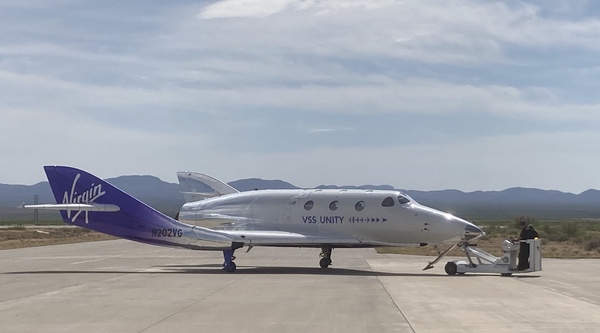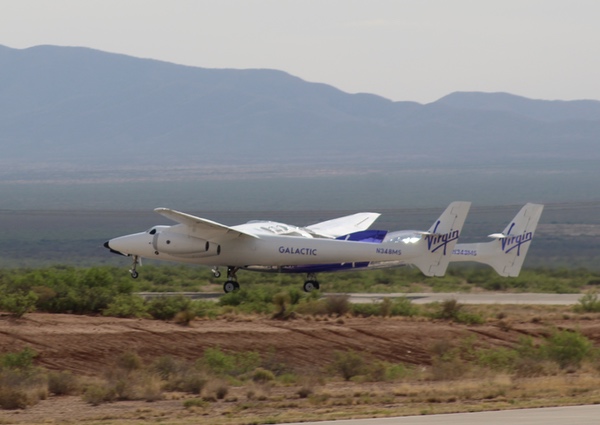Suborbital spaceflight’s crossroadsby Jeff Foust
|
| “It’s better than any ride you’ve taken,” Stern said of his flight on Virgin Galactic. |
In the last two decades, the National Space Society used the hotel for its annual International Space Development Conference (ISDC). In 2006, Virgin Galactic discussed its first group of 100 “founder” astronauts while Burt Rutan wondered what happened to the other X Prize competitors. That conference also featured a talk by SpaceX CEO Elon Musk shortly after the failed first launch of the Falcon 1 where he said the company had been working on designs for a crewed capsule. Musk returned to the same hotel eight years later, the company now flying cargo to the ISS on that Dragon capsule, to accept an award at the 2014 ISDC. Four years later, it was Blue Origin founder Jeff Bezos’s turn to be recognized at the 2018 ISDC there, although his presentation is remembered by most for the announcement that Amazon had acquired the sci-fi series “The Expanse,” saving it from cancellation.
When the ISDC returned to the Sheraton last month, it could now finally recognize people who had flown on commercial suborbital spaceflights. The same award that Musk won a decade ago, the Robert A. Heinlein Memorial Award, this year went to actor William Shatner. The award was primarily for his role on Star Trek, but also for actually going to space on Blue Origin’s New Shepard in 2021.
He mentioned the flight in his remarks accepting the award, even if he got an important detail wrong. “I was asked, after some manipulation, some machination, to go up on the Blue Horizons spaceship,” he recalled, mangling the name of the company that provided him with the ticket.
His comments were a mix of humor, poking fun at Bezos’s flight “on the Blue Horizons ship” before his trip, and revisiting his “enormous experience” on his own flight, including the emotional reaction he had after landing. “It’s apparently not uncommon to feel the preciousness of the Earth,” he said, a reference to the Overview Effect. “I feel in grief for the Earth.”
 William Shatner discusses his suborbital spaceflight on New Shepard at the International Space Development Conference May 24. (credit: J. Foust) |
The day after Shatner’s award, the conference hosted a luncheon with Alan Stern as speaker. He used the speech to discuss his flight on Virgin Galactic’s VSS Unity suborbital spaceplane, testing plans to use the vehicle for research. “It’s like the transition from mainframes to PCs,” he said of the potential of suborbital research, something he has been advocating for more than a decade.
He talked about the long planning, including “overwhelming meetings,” for the flight, as well as the experience of going to space and back in a matter of minutes. “It’s better than any ride you’ve taken.”
The flight Stern took last year was a training run of sorts for an astronomical research flight, funded by NASA, he plans to take with Virgin Galactic. The date of that, though, is not clear after Virgin Galactic announced days after Stern’s flight in November that it would retire VSS Unity and focus its resources on developing the next generation Delta-class vehicle. That will not begin commercial flights until some time in 2026.
The speeches, which could be seen as celebrating the process of suborbital spaceflight, come as the industry approaches a crossroads 20 years after SpaceShipOne’s first trip to the edge of space. Blue Origin has just started resuming crewed New Shepard flights after a long hiatus, but even that mission suffered a problem. Virgin Galactic, meanwhile, is betting the company that it can complete development of those new Delta vehicles and get them into profitable service before the company runs out of cash.
 New Shepard descends with one of its three main parachutes failing to open fully on the NS-25 flight May 19. (credit: Blue Origin webcast) |
Parachute issue
Until recently, New Shepard had not flown any people since a successful flight in August 2022. The following month, on a payload-only flight, an engine problem triggered the capsule’s abort motor, allowing it to land safely while the booster was destroyed. An investigation concluded that the engine nozzle suffered structural failure because of excess heating, leading to design and other changes.
| “They’ve been great at sharing data with us. They don’t really have any kind of root cause yet, and we continue to follow along with them,” NASA’s Stich said of Blue Origin and its parachute issue. |
New Shepard returned to flight last December with another payload-only mission, but the company said at the time that it would resume flying people “soon.” That “soon” turned out to be about five months, with the NS-25 mission launching May 19 with six people on board, most famous among them Ed Dwight, a Black astronaut candidate from the 1960s who completed Air Force training but was never selected by NASA or the Air Force.
The flight, though, was not without incident. During the capsule’s descent, only two of its three parachutes fully opened. That was sufficient for a safe landing, although at perhaps a slightly higher speed than usual: the flight lasted a little under ten minutes, about 20 seconds shorter than average. (Blue Origin, which had displayed speed and altitude during earlier phases of flight, did not for the capsule’s landing.)
Nearly two weeks later, at a briefing about a Boeing CST-100 Starliner launch attempt, NASA confirmed that it had bene notified by Blue Origin of an issue with its parachute so that the agency and Boeing could confirm it did not affect their spacecraft.
Steve Stich, NASA commercial crew program manager, said at the briefing that a line intended for “reefing” the parachute, or controlling the opening of the parachute, was not cut as planned. “In this case, one of the parachutes was stuck in what I would call first stage” of the reefing process, keeping it from opening further.
An investigation confirmed that the problem with the line cutter on the New Shepard parachute was not common to those used on Starliner. Stich praised Blue Origin for its willingness to exchange data. “They’ve been great at sharing data with us. They don’t really have any kind of root cause yet, and we continue to follow along with them.”
Blue Origin provided few other details, beyond that the capsule could safely land even if only parachute opened. “We perform thorough post-flight reviews of every flight system, and that analysis continues,” it said in a statement. “We continue to share data and analysis of our parachute deployment with our chute supplier, NASA, and launch providers.”
The company has not revealed plans for the next New Shepard flight or how many flights it expects to perform this year. Even before NS-25, though, there was speculation in the industry that Blue Origin would deprioritize New Shepard to focus on its New Glenn launch vehicle, Blue Moon lunar lander, Blue Ring transfer vehicle, and Orbital Reef space station: a lot even for a company of the size of Blue Origin or the wealth of its founder.
The assumption is that, for now, Blue Origin will continue New Shepard flights at a modest flight rate: one every month or two, perhaps. But the company’s long-term ambitions appear to be tied to bigger, and more lucrative, projects.
 VSS Unity is towed back to the main terminal building at Spaceport America after the Galactic 07 flight. (credit: J. Foust) |
All in on Delta
Nearly three weeks after New Shepard’s return to crewed flights, Virgin Galactic closed the book on VSS Unity. The Galactic 07 mission included two pilots, three private astronauts, and one Turkish researcher, Tuva Atasever. He conducted several experiments on a flight arranged by Axiom Space, which had flown another Turkish astronaut, Alper Gezeravci, on a mission to the International Space Station earlier this year. (Atasever was the backup on that orbital flight.)
| “Other people have aims of going to Mars, which is equally absolutely and utterly extraordinary,” Branson said. “But what we want to do is enable many people to experience what our astronauts experienced today.” |
Taken in isolation, Galactic 07 was a typical commercial flight for Virgin Galactic. The three private astronauts—their identities not revealed until after Unity glided to a landing back at Spaceport America in New Mexico—said they were thrilled with the experience. Atasever, like Stern, praised the ability to do research on the suborbital spaceplane. “The experimental side of the flight was a huge success,” he said at a press conference after the flight.
The audience for Galactic 07 was bigger than many previous flights, at least since Richard Branson’s trip to space on the vehicle nearly three years ago. That included friends and family of those who flew on the vehicle as well as many company employees. Even Branson himself was there to see the final planned flight of Unity.
In comments after the launch, Branson said he still backed the founding vision of Virgin Galactic sending “thousands and thousands of people” to space. “That’s the aim of Virgin Galactic. Other people have aims of going to Mars, which is equally absolutely and utterly extraordinary,” he said. “But what we want to do is enable many people to experience what our astronauts experienced today.”
To enable that vision, the company needs to be successful on its transition to the Delta-class vehicles. Last November, the company said it would gradually phase out Unity, which was not profitable to operate, so that it could devote its roughly $1 billion of cash on hand to complete Delta and get it into service. The company concluded it could not count on raising more money selling stock give the state of the market—and the state of the company’s share price—and had to focus on getting the Delta vehicles flying.
The plan that Michael Colglazier, CEO of Virgin Galactic, laid out in an earnings call in May calls for getting two Delta vehicles flying in 2026, performing three flights a week with six customers on board, compared to one Unity flight a month with four customers. Virgin will continue to use its existing VMS Eve mothership plane (formerly known as WhiteKnightTwo) for those flights.
“With the launch of just our first two Delta ships, we expect to operate a robust and meaningful business with positive operating cash flow,” he said. Specifically, he projected flying 750 people in that first year of operations, about the size of its current backlog of customers, for an average price of $600,000 each, for $450 million in revenue.
Thus, it becomes a race for Virgin Galactic: demonstrate it can get the Delta spaceplanes flying, and at a flight rate and ticket price that is profitable, before its cash reserves (at $867 million as of the end of the first quarter) are exhausted.
Virgin Galactic is confident it can pull it off because Delta is not a totally new design. On the outside it will look “exactly the same,” Mike Moses, Virgin Galactic spaceline president, told reporters the day before Galactic 07. “But the real change is what’s under the hood, so to speak, in how it was designed, how it was built and how it’s operated.”
| “It was a great flight. Unity flew near perfect. The crew did great,” Moses said. “So, from that standpoint, let’s turn it around and do again. But from a momentum standpoint, we understand we have to stop now and go focus on Delta.” |
That includes the use of different composite materials and manufacturing techniques as well as greater use of contractors, which will build major components of Delta spaceplanes and send them a new facility Virgin Galactic will soon open outside Phoenix where it will perform final assembly and testing. That is a less artisanal approach than development of Unity and its predecessor, Enterprise, in Mojave and intended to be both less expensive and better suited to production of more vehicles.
During the flight hiatus, there will be a lot of work behind the scenes, adjusting procedures at Spaceport America to accommodate a much higher flight rate. “We want to hit the ground running when Delta shows up,” Moses said in an interview after the Galactic 07 flight. That will involve using Unity not as a flight vehicle but one for those ground operational tests.
Once the first Delta vehicle shows up at the spaceport, he said he expected a flight test program lasting roughly 8 to 12 months, starting with glide flights to compare how it handles versus Unity, then into powered spaceflights.
He described as “bittersweet” seeing Unity’s final flight. “It was a great flight. Unity flew near perfect. The crew did great,” he said. “So, from that standpoint, let’s turn it around and do again. But from a momentum standpoint, we understand we have to stop now and go focus on Delta.”
Two decades after SpaceShipOne
The Galactic 07 flight took place less than two weeks before the 20th anniversary of SpaceShipOne’s first flight to 100 kilometers, the precursor to the two flights in September and October 20204 that allowed it to win the $10 million Ansari X Prize.
Nicola Pecile, the Virgin Galactic pilot for the mission, referenced the anniversary in his remarks after the flight. “It is kind of sad to see Unity fly on its last commercial flight,” he said. “But our efforts are really working on the next generation.”
Two decades ago, the flight of SpaceShipOne seemed like a turning point, the opening of a new era commercial human spaceflight. The X Prize was founded in the mid-1990s on the argument that reusable launch vehicles required high flight rates and thus large markets to close their economic cases. Human spaceflight provided that large market and the ability to start with less-demanding suborbital flights before moving into orbital ones and going after new markets.
But that’s not how the future unfolded. Suborbital human spaceflight has not become the stepping-stone to low-cost orbital launch envisioned decades earlier. At best, Blue Origin has used New Shepard to test technologies it will use on its New Glenn orbital rocket, whose first is, perhaps, just a few months away. SpaceShipOne and its successor SpaceShipTwo (VSS Unity) are unlikely to evolve into any kind of reusable orbital launch system.
Suborbital vehicles may have had indirect benefits, like stimulating public interest and passage of legislation to support the commercial launch industry. However, the real innovation in spaceflight in June 2004 was not taking place in the skies above Mojave but a couple hours away in El Segundo, California, where SpaceX was taking its own path towards lowering the cost of accessing space. That was not obvious then—it was easy to dismiss the company as a curious dalliance by a dot-com millionaire—but it is clear today it has had a far greater impact on the space industry than suborbital vehicles.
If the pattern holds, in the next four to six years ISDC will return to the Sheraton Gateway. At that point it will be clear if commercial suborbital human spaceflight has any future. Perhaps Blue Origin will be continuing New Shepard flights at a steady pace, flying several dozen people a year. Virgin Galactic’s bet on Delta may have paid off, allowing the company to at least survive, if not grow into a company flying hundreds a year from New Mexico and possibly other locations. Or, maybe, the suborbital arc will be complete, but not forgotten.
Note: we are now moderating comments. There will be a delay in posting comments and no guarantee that all submitted comments will be posted.
